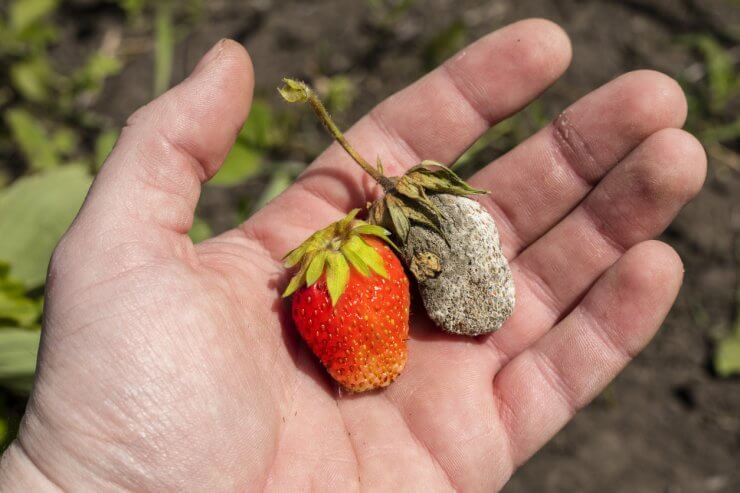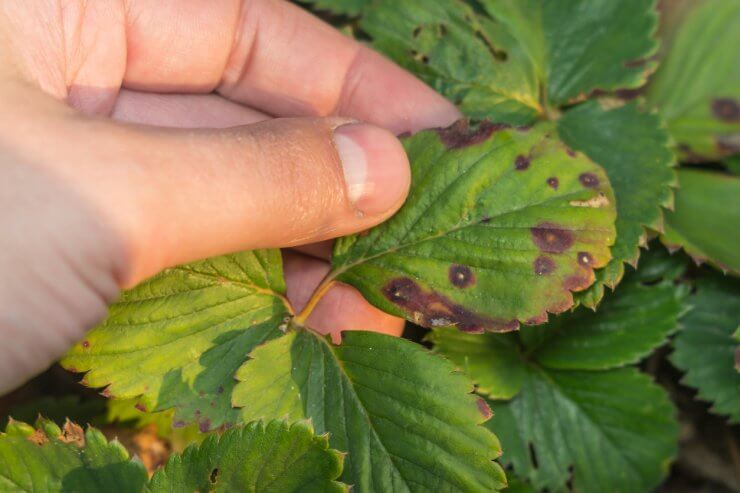
I love strawberries. They’re the perfect little fruit, too. You can cool off on a hot day with a glass of strawberry lemonade. They make a wonderfully sweet addition to yogurt at breakfast. Strawberries work well in a salad with a splash of balsamic vinaigrette. And, of course, you can never go wrong with a strawberry and rhubarb pie!
Unfortunately, here in the northeastern U.S., strawberry season only seems to last a few weeks. That’s why problems like the strawberry anthracnose fungus are so maddening. It can ruin your strawberry patch without a second thought. And weeks of excited anticipation for those juicy, ripe strawberries turn into shattered dreams in a matter of moments. Sigh.
Strawberries are among those odd plants that are happy to grow wild alongside a country road, and at the same time, will test your patience as a gardener if you plant them a little too deeply or they get too much water. Regardless of where they grow, because they are so close to the ground, strawberries are highly susceptible to soil-borne diseases, including the strawberry anthracnose fungus. But you don’t have to live at the mercy of some invisible strawberry killer.

How to diagnose and deal with the anthracnose fungus in strawberries
In actuality, the anthracnose fungus isn’t a single fungus; it’s a group of fungal diseases. The Ohio State University Extension program states that “the two most destructive forms of the disease are crown rot, usually associated with Colletotrichum fragariae, and fruit rot, usually associated with Colletotrichum acutatum.”
We aren’t going to get into the weeds with the different strains of the disease, since the symptoms and the disease management are so similar. But if you’re ever a contestant on Jeopardy and there’s a section on plant pathology, maybe you can give us a little shout-out!
Back to the strawberries, though. Where does this disease come from, and what does it look like? The anthracnose fungus is most often introduced by new strawberry plants. Just like us with some of our human viruses and bacteria, a strawberry plant may be infected without showing any signs or symptoms.
There is also some evidence that the fungus can live in the soil for up to nine months if conditions are right. So, depending on where you live, it’s not impossible to think that the fungus could be present and go unnoticed until late in the season, or even your second planting.
The symptoms of anthracnose fungus may include root rot and wilting, brown, grey, or black lesions on the fruit, or brown spots on the leaves. You may also notice tiny orange fungus spores. The lesions on the fruit may be sunken and firm, and some of the fruit may even mummify. (Who forgot to tell the strawberries that Halloween is in the fall?)
If your plants are infected, your options are pretty much limited to destroying them or applying a fungicide. There is some evidence that neem oil can limit the spread of the fungus. Your best bet, however, is to prevent the disease in the first place.
Here are a few tips on preventing the anthracnose fungus from infecting your strawberries.
- Solarize your soil before planting.
- Thoroughly wash plants and remove all dirt before you plant your strawberries.
- Separate plants. Strawberries are happy in pots and hanging baskets, which gives you an easy way to keep plants far enough apart that an infected plant won’t spread the pathogen.
- Use plenty of mulch to keep a barrier between the soil and your strawberries.
- Use drip irrigation to avoid splashing soil onto your strawberries.
- Plant resistant varieties. Note, however, that these varieties are limited and are still not 100% resistant to anthracnose fungus. The Institute of Agriculture at the University of Tennessee says the “Sweet Charlie” variety may have some resistance to the disease.
- Rotate your crops. Especially if you have a larger garden.
Grow the best strawberries ever!
Ah! The sweet world of strawberries! With our Strawberry Collection, you’ll have everything you need to know about growing and enjoying this wonderful fruit. From the history and background of the sweet strawberry to specific advice about soil requirements and fertilizer … from watering techniques to details about avoiding diseases … from easy-to-make and delicious recipes that will allow you to enjoy the fruits of your gardening labor to the nutritional benefits of strawberries—get it all in our Strawberry Collection right now!
Do you have any experience or advice for dealing with strawberry diseases?


 Previous
Previous

